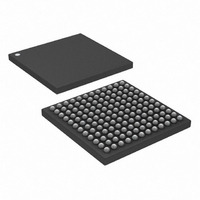DS33X11+ Maxim Integrated Products, DS33X11+ Datasheet - Page 67

DS33X11+
Manufacturer Part Number
DS33X11+
Description
IC MAPPING ETHERNET 144CSBGA
Manufacturer
Maxim Integrated Products
Datasheet
1.DS33X11.pdf
(375 pages)
Specifications of DS33X11+
Applications
Data Transport
Interface
SPI
Voltage - Supply
1.8V, 2.5V, 3.3V
Package / Case
144-CSBGA
Mounting Type
Surface Mount
Lead Free Status / RoHS Status
Lead free / RoHS Compliant
- Current page: 67 of 375
- Download datasheet (3Mb)
________________________________________________ DS33X162/X161/X82/X81/X42/X41/X11/W41/W11
8.16 Quality of Service (QoS) Features
The device contains several features designed to provide Quality of Service (QoS). These features include Virtual
LAN (VLAN) Forwarding and Priority Scheduling/Forwarding supporting both VLAN 802.1p and DSCP. The device
also includes features for Congestion Avoidance and Congestion Management. Information on Congestion
Avoidance using the integrated CIR can be found in Section 8.21. Information on Congestion Management using
Ethernet flow control can be found in Section 8.14.
VLAN Forwarding is used to separate traffic into different streams or combine traffic from multiple sources into a
single stream, while Priority Scheduling is used to prioritize traffic waiting in queue for WAN transmit bandwidth to
become available. Note that Priority Scheduling is different than Priority Forwarding. Priority Forwarding is a
technique used to separate traffic of various priority levels onto physically separate WAN connections. The use of
VLAN Forwarding, Priority Scheduling, and Priority Forwarding is determined by the Forwarding Mode of the
device. More information on the available Forwarding Modes can be found in Section 8.9.
Within the data stream for each WAN Queue group, 802.1p VLAN Priority Coding or DSCP Priority Coding can be
used to assign traffic to 4 different priority queues as discussed in the following sections.
8.16.1 VLAN Forwarding by VID (IEEE 802.1q)
th
The VLAN ID (VID) is a 12-bit field that is found beginning in the 15
byte of VLAN tagged Ethernet frames. The
format of the IEEE 802.1Q VLAN tagged frame is shown in Figure 8-13. The device uses a 4 kilobyte user-
configured “VLAN Table” to translate VLAN tag information into forwarding, trapping, or discarding decisions. For
more details on VLAN Table programming, see Section 8.16.2.
All frames received on the Ethernet interfaces are inspected for a VLAN ID (LAN-VLAN ID) value. The VLAN table
settings for each of the 4096 LAN-VLAN IDs are used to forward each frame to one of the four WAN groups, to
discard the frame, or to extract (trap) the frame. Only when operating in forwarding modes 3, 4, and 5 (as defined
in Section 8.9), can frames be forwarded to one of the four WAN Groups as assigned in the VLAN table. All 12-bit
LAN-VLAN IDs that are translated to the same WAN Group are considered part of the same LAN-VLAN Group.
Note that LAN-VLAN ID trapping must be assigned to an Ethernet Port with the SU.LPM.LEEPS bit, and enabled
with the SU.LPM.LEVIT bit.
All frames received on the WAN interfaces are inspected for a VLAN ID (WAN-VLAN ID) value. ). The VLAN table
settings for each of the 4096 WAN-VLAN IDs are used to forward each frame to one of the Ethernet ports, to
discard the frame, or to extract (trap) the frame. Only when operating in forwarding mode 5 (as defined in Section
8.9), can frames be forward to one of the Ethernet ports by their VLAN ID value. All 12-bit LAN-VLAN IDs that are
translated to the same Ethernet interface are considered part of the same WAN-VLAN Group. Note that WAN-
VLAN forwarding is only applicable when operating in forwarding mode 5. Also note that WAN-VLAN ID trapping
must be assigned to a specific WAN Group with the SU.WEM.WEDS bits and enabled with the SU.WEM.WEVIT
bit.
The LAN-VLAN configuration, used to specify the actions for VLAN ID values in frames received on the Ethernet
interfaces (LAN-to-WAN direction), may be unrelated to the WAN-VLAN configuration, used to specify the actions
for VLAN ID values for frames received on the WAN interface (WAN-to-LAN direction). Although there may be
VLAN tags in both data stream directions (LAN-to-WAN and WAN-to-LAN), the functionality of the device does not
require a symmetrical VLAN function. The LAN-VLAN forwarding and the WAN-VLAN forwarding may be used
independently of each other.
Rev: 063008
67 of 375
Related parts for DS33X11+
Image
Part Number
Description
Manufacturer
Datasheet
Request
R

Part Number:
Description:
MAX7528KCWPMaxim Integrated Products [CMOS Dual 8-Bit Buffered Multiplying DACs]
Manufacturer:
Maxim Integrated Products
Datasheet:

Part Number:
Description:
Single +5V, fully integrated, 1.25Gbps laser diode driver.
Manufacturer:
Maxim Integrated Products
Datasheet:

Part Number:
Description:
Single +5V, fully integrated, 155Mbps laser diode driver.
Manufacturer:
Maxim Integrated Products
Datasheet:

Part Number:
Description:
VRD11/VRD10, K8 Rev F 2/3/4-Phase PWM Controllers with Integrated Dual MOSFET Drivers
Manufacturer:
Maxim Integrated Products
Datasheet:

Part Number:
Description:
Highly Integrated Level 2 SMBus Battery Chargers
Manufacturer:
Maxim Integrated Products
Datasheet:

Part Number:
Description:
Current Monitor and Accumulator with Integrated Sense Resistor; ; Temperature Range: -40°C to +85°C
Manufacturer:
Maxim Integrated Products

Part Number:
Description:
TSSOP 14/A�/RS-485 Transceivers with Integrated 100O/120O Termination Resis
Manufacturer:
Maxim Integrated Products

Part Number:
Description:
TSSOP 14/A�/RS-485 Transceivers with Integrated 100O/120O Termination Resis
Manufacturer:
Maxim Integrated Products

Part Number:
Description:
QFN 16/A�/AC-DC and DC-DC Peak-Current-Mode Converters with Integrated Step
Manufacturer:
Maxim Integrated Products

Part Number:
Description:
TDFN/A/65V, 1A, 600KHZ, SYNCHRONOUS STEP-DOWN REGULATOR WITH INTEGRATED SWI
Manufacturer:
Maxim Integrated Products

Part Number:
Description:
Integrated Temperature Controller f
Manufacturer:
Maxim Integrated Products

Part Number:
Description:
SOT23-6/I�/45MHz to 650MHz, Integrated IF VCOs with Differential Output
Manufacturer:
Maxim Integrated Products

Part Number:
Description:
SOT23-6/I�/45MHz to 650MHz, Integrated IF VCOs with Differential Output
Manufacturer:
Maxim Integrated Products

Part Number:
Description:
EVALUATION KIT/2.4GHZ TO 2.5GHZ 802.11G/B RF TRANSCEIVER WITH INTEGRATED PA
Manufacturer:
Maxim Integrated Products

Part Number:
Description:
QFN/E/DUAL PCIE/SATA HIGH SPEED SWITCH WITH INTEGRATED BIAS RESISTOR
Manufacturer:
Maxim Integrated Products
Datasheet:










